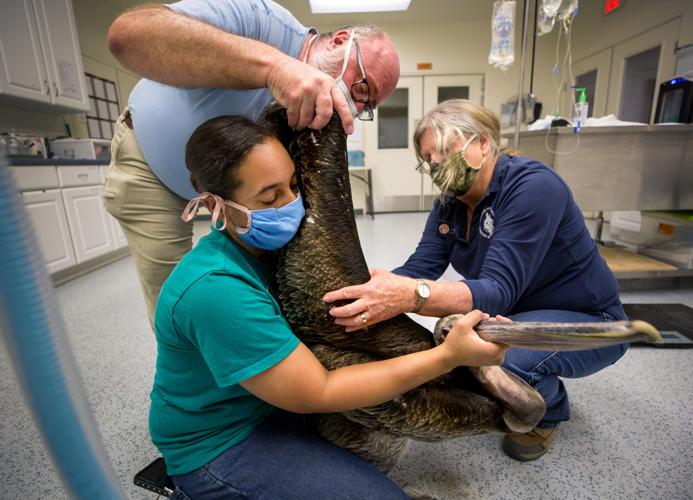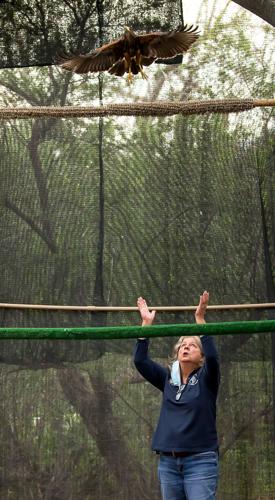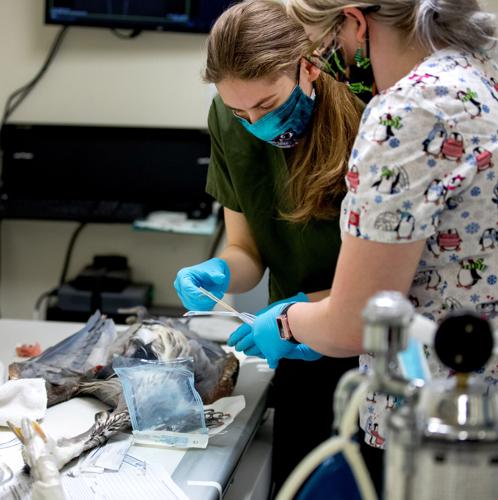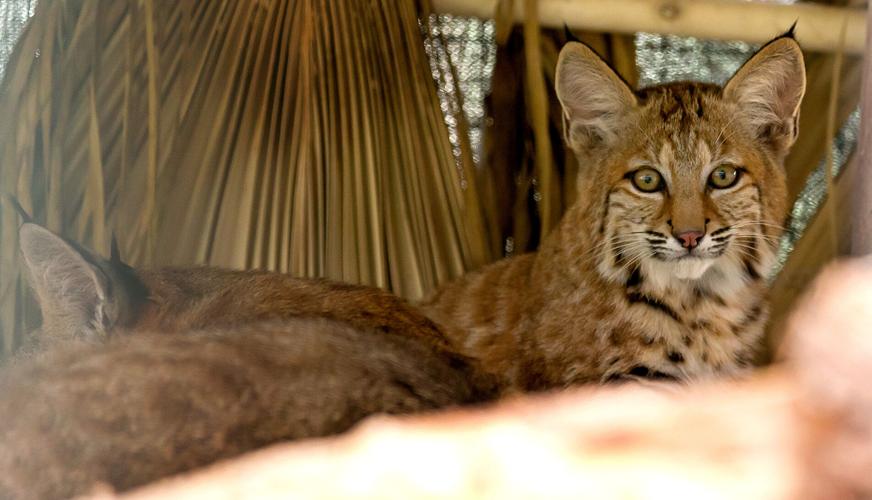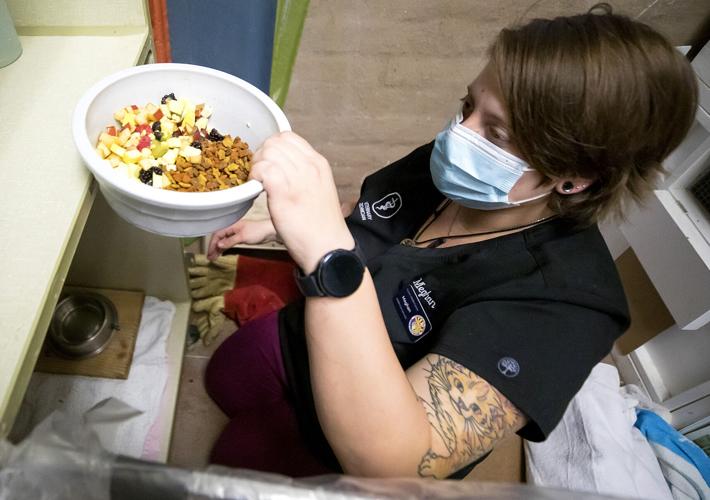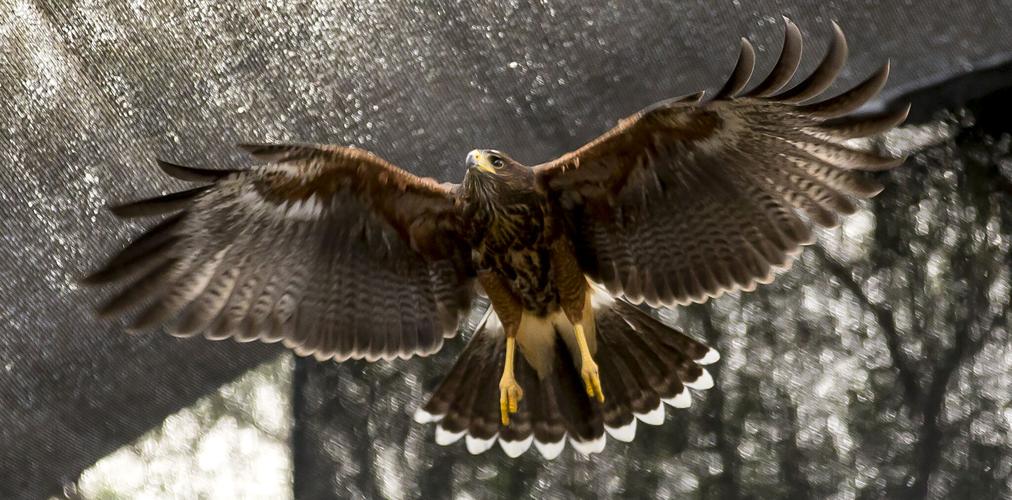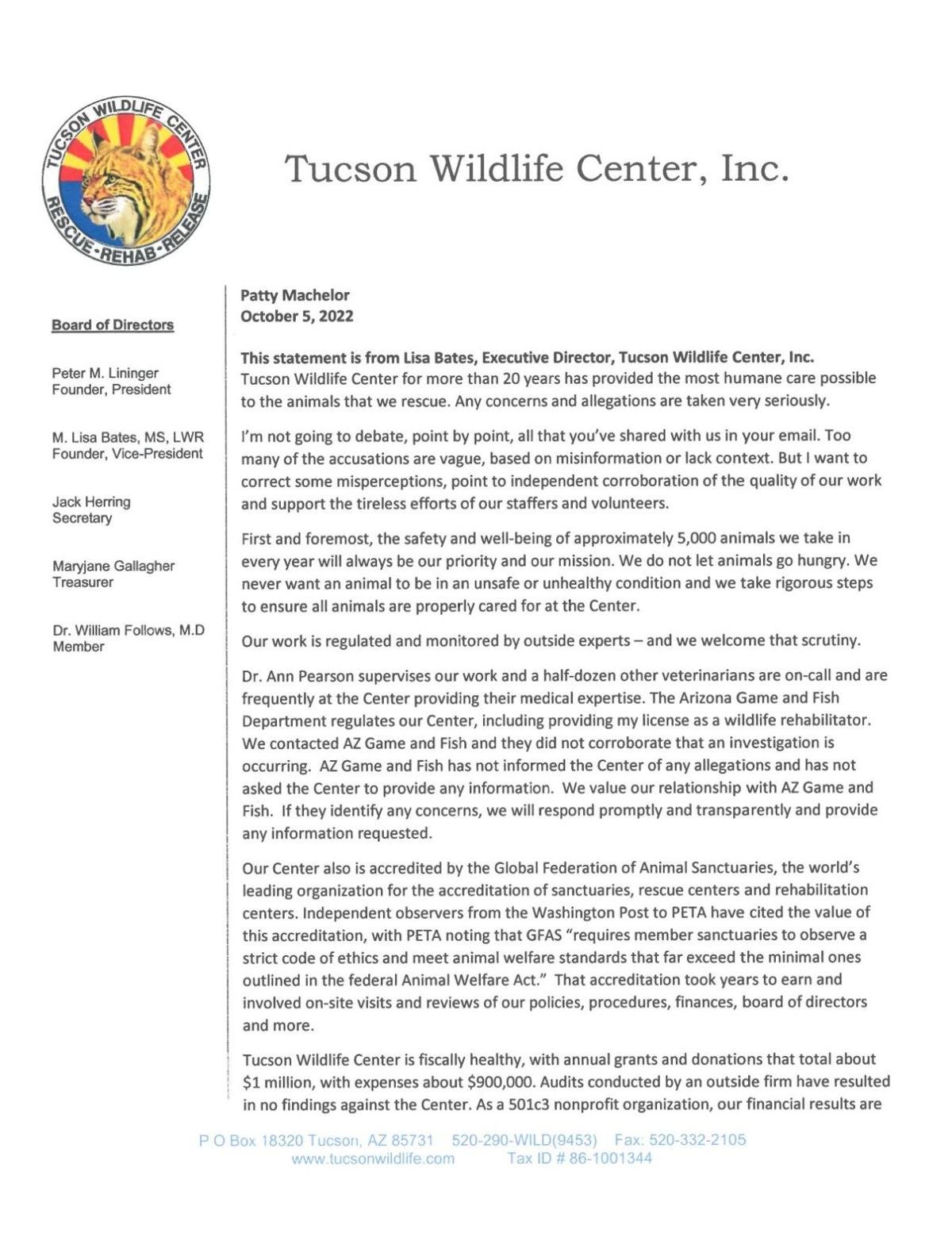Animals arrive at the Tucson Wildlife Center badly injured, victims of a fast car or an aggressive dog.
Others are orphans — baby rabbits, squirrels, or birds — in need of care to ready them for life in the wild.
Southern Arizonans have entrusted the center to care for these desert animals for more than two decades.
But records from Arizona Game & Fish, obtained through a public records request and dating back to 2014, detail accounts of compromised care, lacking protocols, and a negative work environment.

Krista Jennings, left, Tucson Wildlife Center veterinary technician, holds a young Brown Pelican while veterinarian Dr. Roberto Aguilar, top left, executive director Lisa Bates checks on the pelican's wing at Tucson Wildlife Center, on July 2, 2020. Young Brown Pelicans are not common in Arizona but will sometimes show up during monsoon seasons due to increased wind speeds and storms, according to Bates.
In its records, Game & Fish redacted the names of former and current staff, and members of the public, who provided information about the center and its founder and director, Lisa Bates. However, the Star has interviewed 25 people associated with the center, now or in the past, more than half of whom agreed to be named in this story.
Game & Fish officials, who oversee Bates’ rehabilitation license, declined to comment about Bates or the Wildlife Center, citing an ongoing investigation about the center’s regulations, and its compliance with state laws.
State records and interviews cite multiple issues with the center’s treatment of animals. Among the concerns of those who complained:
- Bates made decisions about medical care, and even administered it — including performing surgery on two hawks — even though she is not a veterinarian.
- Animals were unnecessarily euthanized. A December 2020 letter to Game & Fish, for example, detailed how multiple animals were euthanized on the same day with the same note in the system about each one having the same fracture.
- A badly injured tortoise languished for hours because no one knew how to euthanize it.
- Animals lost their fear of humans because of improper handling, making them unable, or unsafe, to return to the wild.
- Animals were released before they were ready, including a great horned owl that could not fly, and was later reported killed by a car.
- Birds and animals were not fed or watered on schedule, and staff without medical training carried out medical care, according to an eight-page letter a Wildlife Center employee sent to Game & Fish in July.
- Bates overruled veterinarians’ recommendations and told staff not to listen to the veterinarians, contributing to the abrupt departures of two staff veterinarians and several veterinary technicians 10 months ago.
One Tucson veterinarian, Jack Quick — who provided free veterinary services at the center for more than a decade and once was president of the center’s board — told Game & Fish that Bates “has conflicts with most everyone she works with.” Attempts to reach Quick for further comment were unsuccessful.
“It was clear that Dr. Quick does not believe that TWC, and the care of the thousands of animals they receive annually, should be in the hands of Ms. Bates any longer,” Lacona de Souza, an urban wildlife specialist with Game & Fish, wrote in a September 2015 memo. “He shared that he and other board members had strategized ways to get Ms. Bates to step down gracefully, to avoid tarnishing TWC’s reputation.”
‘We welcome that scrutiny’
Bates, who founded the center with her husband, Peter Lininger, in 1998, declined opportunities over five days to discuss in detail many of the allegations made against her. However, she did offer a tour of her facility, and responded to a few of the most egregious accusations. She also wrote a letter to the Star.
“We had a turnover of some of our board members after it became apparent that our financial stability was in question, and some disagreements arose regarding the future direction of the Center,” she wrote of the resignation of Quick and other board members.
Bates wrote that many of the accusations against her are vague, and based on misinformation.

Lisa Bates, founder and director of Tucson Wildlife Center, tries to get a Harris hawk to fly at Tucson Wildlife Center on Sept. 29.
“First and foremost, the safety and well-being of approximately 5,000 animals we take in every year will always be our priority and our mission,” she wrote. “We do not let animals go hungry. We never want an animal to be in an unsafe or unhealthy condition and we take rigorous steps to ensure all animals are properly cared for at the Center.”
The center, at 13275 E. Speedway Blvd., had $6.2 million in assets in 2020, the last year tax documents were provided on public searches. The center has received millions in grants and public support over the years, about $5.9 million from 2017-2020, according to tax documents. And in 2015, a 6,000-square-foot animal hospital opened on the property, replacing the existing, 100-square-foot treatment room.
Their work, Bates wrote, is “regulated and monitored by outside experts — and we welcome that scrutiny.”
Bates said her center is accredited by the Global Federation of Animal Sanctuaries, an accreditation that “took years to earn and involved on-site visits and reviews of our policies, procedures, finances, board of directors and more.”
Held in captivity for months
In a 2017 letter to the state’s Attorney General’s Office, attorney Carl Sammartino outlined a dispute between Bates and Game & Fish that began in 2015 and lasted two years.
One of the key problems: Two herds of javelina had been held for months, and some were so used to humans they would eat from a person’s hand. Game & Fish found their release would risk public safety, and that the javelinas were unlikely to survive if freed, so they were transferred to live at zoos.
Under the rules set by Game & Fish, a wildlife rehabilitator is restricted to holding animals no more than 90 days with the exception of birds, which can be held for up to 180 days. Any extensions have to be authorized.

A veterinarian and vet technician work on getting a pellet out of the wing of a great blue heron at the Tucson Wildlife Center on Dec. 22, 2020.
The wildlife agency also warned Bates that she was not to perform surgery, or other medical procedures, after finding that “Bates, and TWC staff under her direction, had attempted on their own to surgically repair the fractured humerus of two hawks on two separate occasions.”
Bates was initially perplexed anyone would accuse her of this, and said it was a “very serious allegation,” but, in a later email to the Star, said she did perform surgery on one hawk — even though she does not have medical training to do so.
“If surgery wasn’t performed immediately the hawk would have died,” she wrote. “I was advised by two doctors that assisted us and who were not available, that I should do this because it was a crisis with no other options and because of my 15 years of orthopedic surgical nursing experience.”
The outcome was successful, she wrote, and the hawk was eventually released.
Former employee Lou Rae Whitehead was at the center when Bates performed surgery on a hawk, one of two the state has reported. Afterward, Whitehead said, one of the other staffers was upset, and wrote to Game & Fish about it.
“We couldn’t find a vet to help us,” Whitehead said, “and she had me help her perform the surgery.”
Whitehead, who worked at the center for over a decade and now has her rehabilitation license, said the habituation of not only javelina, but also bobcats and racoons, was a big problem at the center.
There were not proper protocols in place, she said, to keep the animals afraid of humans.

An orphaned bobcat sits next to Ruby, a foster bobcat, at Tucson Wildlife Center.
Return them to the wild
On a recent Thursday, veterinarian Ann Pearson was volunteering at the center, checking on animal patients, and excited to see a great horned owl was well enough to move into an outdoor enclosure, that much closer to release.
“I was so happy when it flew,” she said afterward. “It makes you feel so good when you can release them, and get them back out in the wild.”
One of Pearson’s first memories of Bates and wildlife rescues was in the late 1990s, around the time the center first opened. Pearson, who used to be Bates’ horse vet, helped Bates rescue a deer drowning in a watering trough. Over the years since, she’s volunteered occasionally at the center. This year, that’s increased.
“I’ve been out more this last year,” she said. “I know she’s been short-staffed.”
Linda Smith, a center supervisor, was one of four current employees and volunteers who spoke positively to the Star about working at the center.
“Like with any other place of employment, there are people that are dissatisfied for one reason or another,” Smith said, adding that it’s “really obvious” that Bates cares about the animals. “I’ve got nothing but respect for her.”
Tucson City Councilman Steve Kozachik said he has worked with Bates and her staff for the last 10 years, collaborating to move animals when the Tucson Fire Department does controlled burns, for example.
“The work they do is uniquely important, and it’s uniquely challenging,” he said. “The animals that come in are in crisis, and every situation is unique.”
In addition to the Tucson Wildlife Center, Game & Fish, and the public in Southern Arizona, have one licensed wildlife rehabilitator operating from home here to help wild animals. Statewide services for wild animals are also offered through Wild at Heart, Southwest Wildlife Conservation Center, and Liberty Wildlife, all based in Phoenix.
‘Disgusted by the events’
In late-April, a center employee contacted Game & Fish about a badly mauled tortoise brought in the morning of April 23. The employee, who no longer works there, relayed that the tortoise had been left to suffer for hours because no one knew how to euthanize it, and no one with reptile experience was called in to help. The worker spoke to the Star to confirm what is in the report but asked not to be named.
Initially, the employee wrote, the tortoise was “put under anesthesia for approximately 30 minutes to see if if would pass that way.”
“After this method failed, (Bates) made the executive decision to simply put the tortoise in the box it arrived in and let it sit in the surgery room in the hospital to slowly die,” the employee told Game & Fish, an incident report shows.
Copies of a texting chat about the tortoise, between the employee and a former employee, were also included, as well as a video of the tortoise alive in the box. Around 6 p.m. that day, and after Bates had reportedly left, this employee contacted a veterinary technician who used to work there and says that person guided another technician through the euthanasia process.

Meghan Cochran, vet assistant care specialist, places food down for a group of baby raccoons at Tucson Wildlife Center.
“I was, and still am, disgusted by the events that took place that day,” the employee wrote to Game & Fish, “and I can firmly say that with the experiences I’ve seen at the center, Lisa Bates is inept and incapable of running her center as she consistently makes decisions that hurt the animals in her care.”
During the tour of her facility, Bates told the Star this is not what occurred.
Instead, she said, the worker who reported the incident lacked an understanding of the process: All animals are given anesthesia before they are killed so they are unconscious before receiving the euthanasia drug.
“I attended this tortoise immediately on intake and after seeing the extreme injuries, followed the above procedures without delay, by the book,” she later wrote in an email. “He went to sleep after five minutes of anesthesia. He was no longer suffering at that point and never regained consciousness.”
‘Lots of times, it’s just not possible’
Bates said she no longer has a staff veterinarian, or veterinarians, because it’s cheaper to have volunteer vets. She said there are seven on call for her, including two veterinarians that specialize in orthopedic issues and one that’s an eye specialist.
In addition to Pearson, the center provided the names of two other volunteer veterinarians to the Star, and one did not respond to interview requests.
Dr. Don Gehringer and his wife, who is also a veterinarian, have been volunteering at the center since last spring. Gehringer said they were coming in as needed until about a month ago, when they started volunteering more regularly, including visits on Mondays, Wednesdays and Fridays.
“We have been very impressed with their abilities, and the way people work and handle the animals,” he said. “I haven’t seen anything that would make me think that what they’re doing is inhumane or incorrect.”
The work is very difficult, he said. Unlike domesticated animals, wild animals must be able to survive again in the wild, and so there’s “a relatively low success rate.”
“Lots of times, it’s just not possible to save them,” he said, “if they are going to be debilitated or slowed in any kind of way.”
Veterinarians’ recommendations ignored
Gabi Lizarraga cleaned cages and prepared food as a Wildlife Center volunteer, and then was hired on. She spent almost six years at the center before she left in May.

A Harris hawk, that is due to be released soon, takes flight at Tucson Wildlife Center.
“The job was everything I could want. I loved what I did,” she said, explaining she eventually became a care specialist for small birds and small mammals. “However, it got to a breaking point, and I had to step away.”
After the veterinarians left, Lizarraga said animals were being sent to her building that should have already been euthanized.
“I was receiving animals with illnesses or injuries that should have been detected,” she said. “They were dying, and it was really upsetting.”
Orion Reager was there through Lizarraga’s time, first as a volunteer starting in fall 2020, and then as a wildlife care manager, starting in spring 2021. He resigned in spring 2022.
In the aviaries, he said, there were regular discussions about which birds were ready for release, and the veterinarians working there would put notes on the cages indicating a bird’s medical status. Reager said Bates undermined their work.
“She started to tell me that the vets didn’t know what they were doing, and not to listen to them,” he said. After the two staff veterinarians quit, Reager said no one was allowed to know who the on-call vets were or ask them questions directly.
“She decided none of the staff should be allowed to talk to the vets,” Reager said, “only her.”
Volunteer Carol Wilson’s passion is helping hummingbirds, and so she worked to bring in $2,267 in donations for a hummingbird rehabilitation area at the center. Her funds were in addition to another larger contribution of $25,000, which was donated for the hummingbirds during a March benefit auction.
But Wilson’s dream of starting — and eventually helping oversee — the rehabilitation of hummingbirds at the center ended late this spring.
“She told me I was going to head up the hummingbird area, then she never set it up at all,” Wilson recalled. Bates, during the tour of her facility, pointed out the building, currently empty, that’s been designated for hummingbird care.
Wilson is concerned about the tiny birds’ care there, especially the orphans. “They don’t know how to feed them,” she said. “You cannot have 14 different people feeding baby hummingbirds. They die.”
The feeding process is a delicate one, she said, because if too much fluid builds up the bird will go into respiratory failure. Unskilled feeders can also easily puncture the bird’s crop, which is a storage area between the mouth and the stomach.
Like others, Wilson said she was also shocked by Bates’ disregard for the veterinarians.
“The vet says one thing and then she says, ‘Don’t pay attention to that,’” she said. Nowadays, Wilson said she would not bring a bird there.

In this 2007 photo, Lisa Bates, executive director for Tucson Wildlife Center, examines the foot of a red-tailed hawk with a fractured wing and a staph infection of the foot at Tucson Wildlife Center.
Jean Keplinger was a volunteer before she became a manager at Tucson Wildlife Center, and says she tried hard to help before finally resigning in April.
During her time with the center, Keplinger became a certified rehabilitator and then, briefly, took a job as a seasonal wildlife rehabber in New Mexico.
When she returned, one of the staff veterinarians was gone and the other would soon be leaving. Keplinger initially agreed with Bates that the center, in the absence of full-time vets, could operate with on-call vets, a model not uncommon with wildlife centers.
“The problem came when (Bates) did not enlist experienced vets or allow us to contact them without going through her,” Keplinger said. “And she never followed through in a timely manner, so many (animal) patients suffered.”
Keplinger said she implored Bates to hire a more experienced rehabber, or a hospital manager.
“She kept saying she would, but never did,” she said. “I resigned because she put me in a position that required more skill and experience than I was capable of handling. And also, because she made so many incredibly poor decisions, never allowing me to have a conflicting opinion.”
Alison Huber helped improve protocols in the small animal and bird unit there after starting as a volunteer in 2014. Huber, who has a degree in wildlife conservation and did field work in ornithology before working at the center, said she resigned in January 2020 because Bates was undermining her work.
When she resigned, she said she was supervising more than 80 volunteers, and overseeing eight to 10 shift leaders.
“I think that might be why she treated me so badly at the end,” she said of Bates. “She realized that I was truly in charge of a large part of the organization, and she couldn’t have that.”
People speaking out now are doing so because they are concerned about the animals, Huber said. There are many still afraid to do so, she said.
“We were all so dedicated to the wildlife, and to making it all better in any way we could,” she said. “It could be a wonderful asset to Southern Arizona. But, because Lisa cannot, or will not, willingly delegate any part of it, the place is falling apart.”
‘Can they survive?’
In early June this year, a Tucson resident found a great horned owl fledgling with a wound to its left leg. In a letter to Game & Fish, the person — whose name was redacted — included a photo of the owl with its left leg bandaged and a detailed account of something that was upsetting.
The resident and neighbors took the bird to the wildlife center on June 14 and were told the bird had been able to perch and fly and should recover quickly. However, when the resident called July 2, they were told the owl had fractured its right femur.
“When he made his third call, July 18, he left his name and number and was told someone would call him in a day or two. When that call was not returned, he called on July 21. This was the first time we learned that our owl had been euthanized on June 14, the day it arrived at the Wildlife Center, because it had a fracture in the right leg bone.”
The letter writer and neighbors wanted to know what had happened, why they had been told for more than three weeks that the bird was recovering, and then were told the owl was killed because its right femur was crushed.
Bates, the writer said, insisted that they must have given the wrong date for the bird’s arrival, interrupted him when he was explaining that they had a number for the bird to track it, and “sounded fed up” before abruptly ending the call.
The Star texted a copy of the letter to Bates, but she did not respond.
It was the plight of another bird of prey that caused Marcy Tigerman to leave the center after volunteering for more than two years. She loved aspects of her work there: bottle-feeding baby animals and seeing predators that people don’t typically see up close.
But while those experiences were positive, she found much of what happened there inconsistent, and disturbing.
One week, Tigerman said, staff would be talking to baby raccoons, letting them climb all over them, “and then the next week they’d say, ‘You can’t do that, they can’t get used to you,’ “ she said. The same happened with the birds of prey, she said: One week staff and volunteers would wear ghillie suits to prevent the birds from getting used to people and the next month, no one would be wearing them.
“I didn’t see any kind of policy or procedure that showed the hard work we did as volunteers, and the money donated, resulted in these animals being able to sustain themselves after they were released,” she said.
The experience that made her quit: she and a fellow volunteer took a great horned owl that had gone through rehabilitation, and was deemed ready for release, to the apartment complex where it had been found. Once there, they discovered it could not fly. They called back to the center, she said, but were told to leave it there.
Within a week, she heard an upset resident had called: The owl had been killed by a car.
While it’s a “feel-good thing” to save wild animals, Tigerman said, it comes with great responsibility.
“In the end,” she asked, “can they survive when they leave?”



